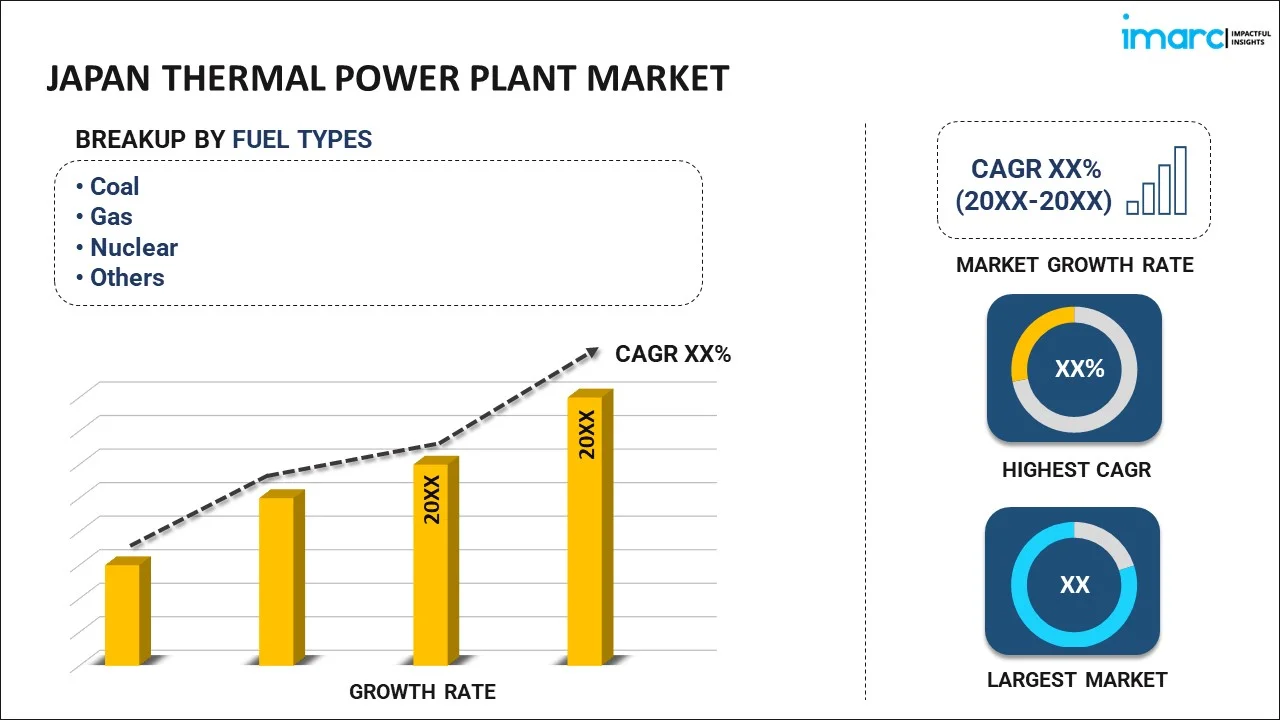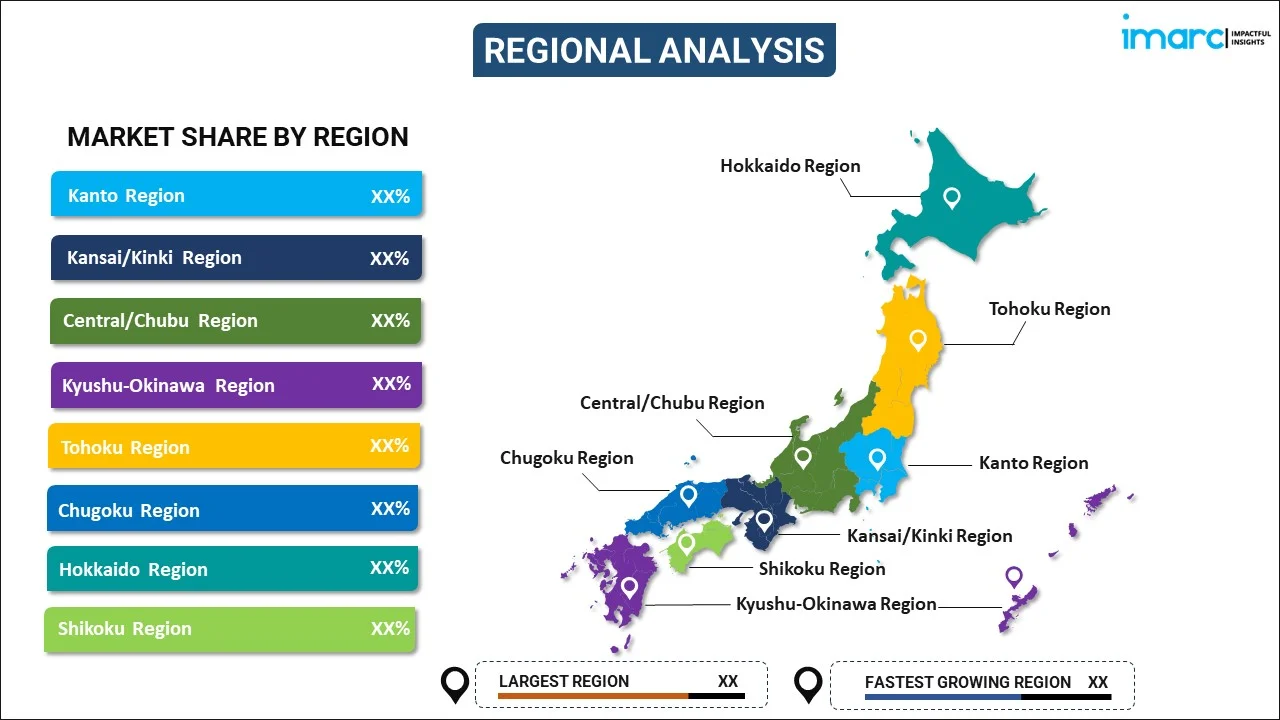
Japan Thermal Power Plant Market Report by Fuel Type (Coal, Gas, Nuclear, and Others), and Region 2025-2033
Market Overview:
Japan thermal power plant market size reached 724.3 TWh in 2024. Looking forward, IMARC Group expects the market to reach 823.8 TWh by 2033, exhibiting a growth rate (CAGR) of 1.44% during 2025-2033. The growing development of urban living spaces, coupled with the increasing need for steady and secured power supply, is primarily driving the market growth.
|
Report Attribute
|
Key Statistics
|
|---|---|
|
Base Year
|
2024 |
|
Forecast Years
|
2025-2033 |
|
Historical Years
|
2019-2024
|
| Market Size in 2024 | 724.3 TWh |
| Market Forecast in 2033 | 823.8 TWh |
| Market Growth Rate (2025-2033) | 1.44% |
A thermal power plant is a facility dedicated to the generation of electricity through the conversion of heat energy. Typically, this heat is derived from the combustion of fossil fuels, such as coal, oil, or natural gas, although newer technologies also allow for the use of renewable heat sources. The fundamental principle governing these plants is the transformation of thermal energy into mechanical energy, which subsequently drives a generator to produce electricity. During this process, water is often heated to produce steam, which then turns a turbine connected to an electrical generator. As the global energy demand continues to rise, thermal power plants play a quintessential role in ensuring a steady supply of electricity to both residential and industrial sectors. However, given environmental concerns associated with burning fossil fuels, such as greenhouse gas emissions and air pollution, there's a growing emphasis on optimizing efficiency and exploring sustainable alternatives within the realm of thermal power generation.
Japan Thermal Power Plant Market Trends:
The Japan power plant market is chiefly propelled by significant advancements in thermal power technologies across the country, particularly within its evolving energy landscape. These systems are extensively employed to ensure and regulate power generation in both densely populated urban areas and isolated regions, given their capability to deliver consistent energy output in the face of unpredictable energy demands, combined with their cost-effectiveness relative to other energy sources. The market's expansion is further buoyed by the escalating need for efficient and stable energy sources to cater to Japan's modern infrastructure and industries. This demand is complemented by Japan's robust economic framework and the increased integration of technologically advanced machinery and appliances. Moreover, numerous industry players are diligently channeling efforts into research and development (R&D) initiatives to innovate thermal power solutions endowed with advanced functionalities, encompassing adaptive operational capabilities, superior diagnostic systems, intelligent load distribution, and maximized energy extraction. The convergence of these thermal power systems with contemporary digital paradigms augments market prospects further. Additionally, the introduction of integrated thermal systems, which synergize conventional heat sources with sustainable alternatives like geothermal or ocean thermal energy, is expected to drive the Japan thermal power plant market in the coming years.
Japan Thermal Power Plant Market Segmentation:
IMARC Group provides an analysis of the key trends in each segment of the market, along with forecasts at the country level for 2025-2033. Our report has categorized the market based on fuel type.
Fuel Type Insights:

- Coal
- Gas
- Nuclear
- Others
The report has provided a detailed breakup and analysis of the market based on the fuel type. This includes coal, gas, nuclear, and others.
Regional Insights:

- Kanto Region
- Kansai/Kinki Region
- Central/ Chubu Region
- Kyushu-Okinawa Region
- Tohoku Region
- Chugoku Region
- Hokkaido Region
- Shikoku Region
The report has also provided a comprehensive analysis of all the major regional markets, which include Kanto Region, Kansai/Kinki Region, Central/ Chubu Region, Kyushu-Okinawa Region, Tohoku Region, Chugoku Region, Hokkaido Region, and Shikoku Region.
Competitive Landscape:
The market research report has also provided a comprehensive analysis of the competitive landscape in the market. Competitive analysis such as market structure, key player positioning, top winning strategies, competitive dashboard, and company evaluation quadrant has been covered in the report. Also, detailed profiles of all major companies have been provided.
Japan Thermal Power Plant Market Report Coverage:
| Report Features | Details |
|---|---|
| Base Year of the Analysis | 2024 |
| Historical Period | 2019-2024 |
| Forecast Period | 2025-2033 |
| Units | TWh |
| Scope of the Report | Exploration of Historical Trends and Market Outlook, Industry Catalysts and Challenges, Segment-Wise Historical and Future Market Assessment:
|
| Fuel Types Covered | Coal, Gas, Nuclear, Others |
| Regions Covered | Kanto Region, Kansai/Kinki Region, Central/ Chubu Region, Kyushu-Okinawa Region, Tohoku Region, Chugoku Region, Hokkaido Region, Shikoku Region |
| Customization Scope | 10% Free Customization |
| Post-Sale Analyst Support | 10-12 Weeks |
| Delivery Format | PDF and Excel through Email (We can also provide the editable version of the report in PPT/Word format on special request) |
Key Questions Answered in This Report:
- How has the Japan thermal power plant market performed so far and how will it perform in the coming years?
- What has been the impact of COVID-19 on the Japan thermal power plant market?
- What is the breakup of the Japan thermal power plant market on the basis of fuel type?
- What are the various stages in the value chain of the Japan thermal power plant market?
- What are the key driving factors and challenges in the Japan thermal power plant?
- What is the structure of the Japan thermal power plant market and who are the key players?
- What is the degree of competition in the Japan thermal power plant market?
Key Benefits for Stakeholders:
- IMARC’s industry report offers a comprehensive quantitative analysis of various market segments, historical and current market trends, market forecasts, and dynamics of the Japan thermal power plant market from 2019-2033.
- The research report provides the latest information on the market drivers, challenges, and opportunities in the Japan thermal power plant market.
- Porter's five forces analysis assist stakeholders in assessing the impact of new entrants, competitive rivalry, supplier power, buyer power, and the threat of substitution. It helps stakeholders to analyze the level of competition within the Japan thermal power plant industry and its attractiveness.
- Competitive landscape allows stakeholders to understand their competitive environment and provides an insight into the current positions of key players in the market.
Need more help?
- Speak to our experienced analysts for insights on the current market scenarios.
- Include additional segments and countries to customize the report as per your requirement.
- Gain an unparalleled competitive advantage in your domain by understanding how to utilize the report and positively impacting your operations and revenue.
- For further assistance, please connect with our analysts.
 Inquire Before Buying
Inquire Before Buying
 Speak to an Analyst
Speak to an Analyst
 Request Brochure
Request Brochure
 Request Customization
Request Customization




.webp)




.webp)












